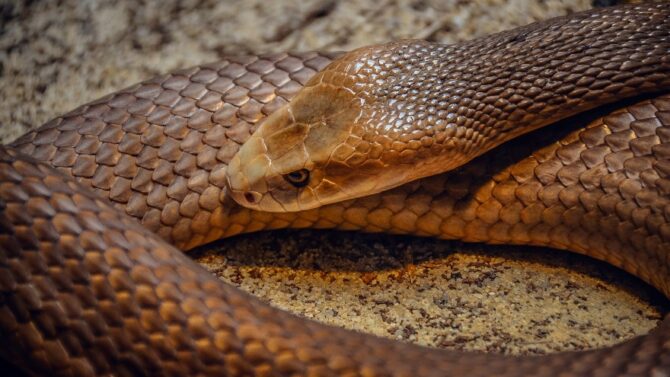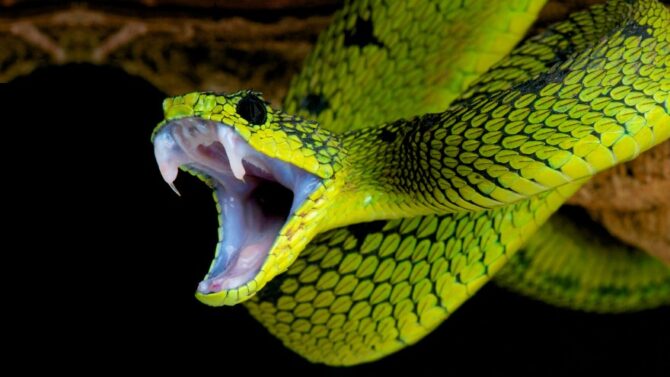Are you curious about the difference between venomous vs non-venomous snakes?
While snakes are often feared and dreaded by humans, not all of them pose a threat.
These reptiles come in various lengths, sizes, and colors, often blending in with their environment as a defense mechanism.
Some snakes reside on the ground, while others make their home in trees.
Venomous snakes defend themselves by spitting poisonous substances, while non-venomous snakes do not.
Some non-venomous species can even serve as pets or have medicinal purposes.
Contrary to popular belief, most snakes are not venomous.
In this article, we’ll explore the differences between venomous and non-venomous snakes and provide more information about the various types of snakes out there.
Brief Overview of Snakes
Venomous Snake

Venomous snakes are a group of species of dangerous reptiles that can produce toxic saliva-containing venoms known as zootoxins.
These venoms can incapacitate or render other living things known as prey impotent and make the prey digestible.
It is also used for self-defense against threats or perceived predators in the snake’s environment.
The venom contains many toxic compounds that have both neurotoxic and hemotoxic properties.
These can lead to permanent disabilities like blindness or the death of the victim of the attack.
The toxin nature of the venom poses potential dangers to humans.
However, the effects of the venom on the prey depend on the quantity of venom delivered with the bite, the efficiency of the delivery mechanism, and the location of the bite on the body of the victim.
There are over six hundred of these dangerous reptiles globally.
Some of them include the families Elapidae, Viperidae, Atractaspididae, etc.
Non-Venomous Snakes

These are the species of snakes or serpents that do not produce venom(toxic, dangerous saliva).
Most snakes referred to as non-Venomous do not produce venom or toxin that are clinically significant.
Though non Venomous snakes are not dangerous and pose little danger to the environment, they still need to be given spaces, as provoking them may be dangerous.
Also, differentiating the two may be difficult at first sight.
Furthermore, some non Venomous snakes, like pythons, are one of the deadliest and most dangerous snakes on the planet.
However, it’s edible and serves as medicine for lots of ailments.
Venomous vs Non-Venomous Snakes: What are the Differences?
1. Venom
The venomous snake can produce venom, which is a poisonous substance that poses potential dangers to their potential prey.
Non-venomous snakes cannot produce venom. However, both species are more than capable of instilling fear and terror in human beings and other living creatures.
2. Shape of head
Another distinction between the two species is the way their heads look.
Venomous snakes have more triangular heads, which often deter predators. Non-venomous snakes have rounded heads.
However, a non-venomous snake can mimic a venomous snake by flattening their head to appear more triangular as a defense mechanism.
This can confuse the potential prey because venomous snakes’ heads are very wide at the base close to the neck, while non-venomous snakes don’t have the same width to their head.
3. The shape of their pupils
Another easy distinction between venomous snakes and non-venomous snakes is the appearance of their pupils.
Venomous snakes have vertical pupils like cats with narrow slits.
Coming across them during the daytime is scary enough: at night, it will be downright frightening.
Non Venomous snakes have round pupils similar to the shape of their heads, and the pupils fill out their entire eyes.
However, some species of snakes don’t conform to these particular looks.
Although the last thing that may come to mind when you stumble upon a snake will be to study its eyes briefly, try to.
It could be what saves you from possible death.
4. The presence of pits
Venomous snakes have unique holes in between their nostrils and eyes that enable them to detect subtle changes in temperature in their environment.
This helps them easily locate their prey leading up to eminent capture and dinner.
Non-venomous snakes do not have this advantage. To hunt their prey, they constrict them.
Constriction includes biting the selected prey, surrounding them with their body, and then suffocating them.
5. Rattles
Most venomous snakes have rattles at the end of their tails. Some particular species don’t possess this appendage (the cottonmouth is an example).
Non-venomous snakes don’t have rattles; they do have the ability to mimic the rattle-like sound.
The rattle aims to warn off predators in the surrounding environment and to confuse prey.
It advertently constitutes a warning to potential prey to run away before it strikes.
The snake rattle is made up of special hollow scales, which contain keratin at the top.
These scales are loosely connected; this explains why a buzzing noise is produced when the snake vibrates its tail.
6. Markings and coloring
Another distinction between Venomous and non Venomous snakes is that most venomous snakes can have a vivid and distinct color and marking.
Non-venomous snakes are solidly colored without any brightness and distinct markings.
However, this distinction has some exceptions, as some examples of venomous snakes may have color and markings like non Venomous snakes and vice versa.
Conclusion
The venomous snakes are very dangerous and aggressive, while non Venomous snakes still bite and behave aggressively, especially when provoked, but they can’t inject their prey like the venomous snakes.
However, the knowledge of venomous vs non-venomous snakes is essential.
It will help you protect yourself from these predators that are capable of rendering human beings impotent and can cause death with their toxic saliva.
However, the toxins are useful for the production of some medicine.






![How Often Do Corn Snakes Shed Their Skin [Answered]](https://animalvivid.com/wp-content/uploads/2022/11/How-Often-Do-Corn-Snakes-Shed-Their-Skin-Answered.jpg.webp)